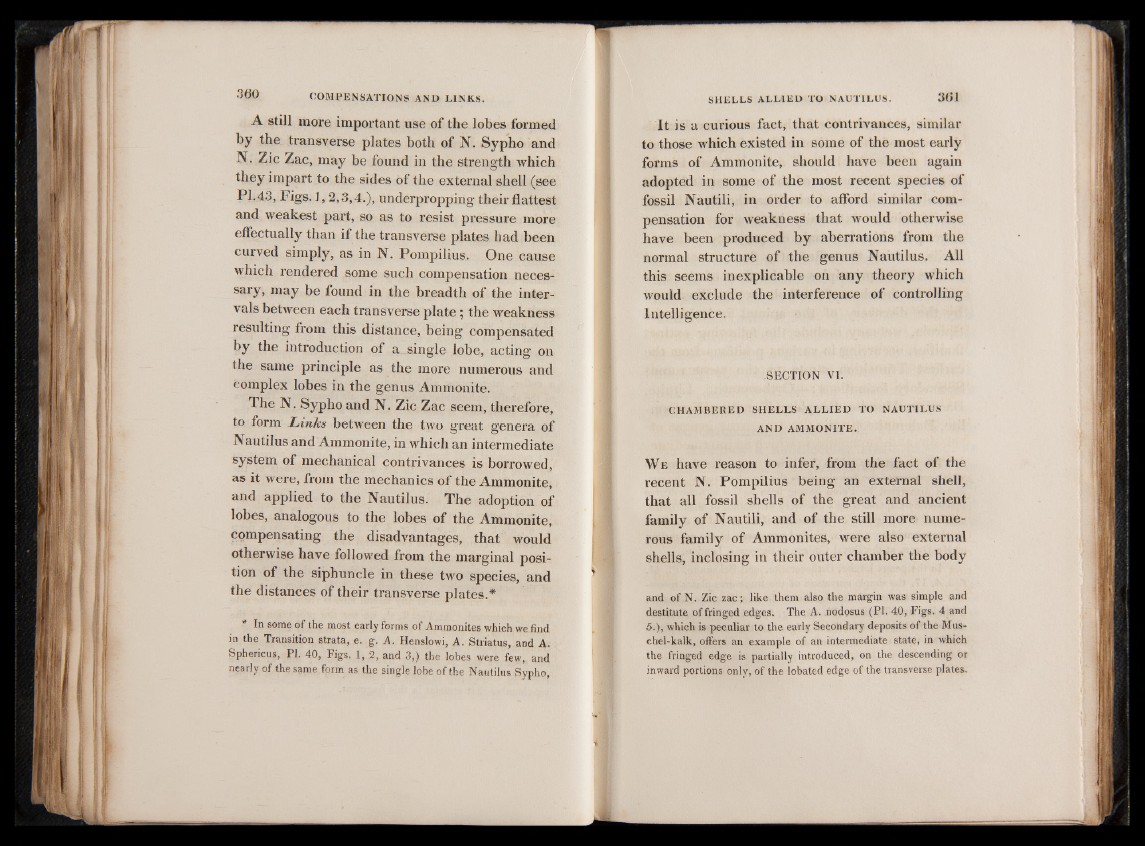
A still more important use of the lobes formed
by the transverse plates both of N. Sypho and
N. Zic Zac, may be found in the strength which
they impart to the sides of the external shell (see
PI.43, Figs. 1,2,3,4.), underpropping their flattest
and weakest part, so as to resist pressure more
effectually than if the transverse plates had been
curved simply, as in N. Pompilius. One cause
which rendered some such compensation necessary,
may be found in the breadth of the intervals
between each transverse plate; the weakness
resulting from this distance, being compensated
by the introduction of a single lobe, acting on
the same principle as the more numerous and
complex lobes in the genus Ammonite.
The N. Sypho and N. Zic Zac seem, therefore,
to form Lin k s between the two great genera of
Nautilus and Ammonite, in which an intermediate
system of mechanical contrivances is borrowed,
as it were, from the mechanics of the Ammonite,
and applied to the Nautilus. The adoption of
lobes, analogous to the lobes of the Ammonite,
compensating the disadvantages, that would
otherwise have followed from the marginal position
of the siphuncle in these two species, and
the distances of their transverse plates.*
* In some of the most early forms of Ammonites which we find
in the Transition strata, e. g. A. Henslowi, A. Striatus, and A.
Sphericus, PI. 40, Figs. 1, 2, and 3,) the lobes were few, and
nearly of the same form as the single lobe of the Nautilus Sypho,
It is a curious fact, that contrivances, similar
to those which existed in some of the most early
forms of Ammonite, should have been again
adopted in some of the most recent species of
fossil Nautili, in order to afford similar compensation
for weakness that would otherwise
have been produced by aberrations from the
normal structure of the genus Nautilus. All
this seems inexplicable on any theory which
would exclude the interference of controlling
Intelligence.
-SECTION VI.
CHAMBERED SHELLS A L L IE D TO NAUTILUS
AND AMMONITE.
W e have reason to infer, from the fact of the
recent N. Pompilius being an external shell,
that all fossil shells of the great and ancient
family of Nautili, and of the still more numerous
family of Ammonites, were also external
shells, inclosing in their outer chamber the body
and of N. Zic zac; like them also the margin was simple and
destitute of fringed edges. The A. nodosus (PI. 40, Figs. 4 and
5.), which is peculiar to the early Secondary deposits of the Mus-
chel-kalk, offers an example of an intermediate state, in which
the fringed edge is partially introduced, on the descending or
inward portions only, of the lobated edge of the transverse plates.